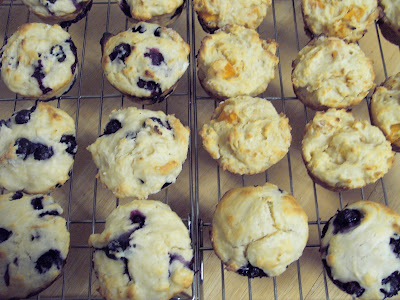 We have been buying fat free buttermilk lately, only because it's easier to obtain- it's the version carried by the merchants we usually shop at. And it's hard to rationalize against saving on the fat if the results are the same. But we don't think the results are the same. We have tried it in pancakes and buttermilk muffins and are having to adjust the recipes.
We have been buying fat free buttermilk lately, only because it's easier to obtain- it's the version carried by the merchants we usually shop at. And it's hard to rationalize against saving on the fat if the results are the same. But we don't think the results are the same. We have tried it in pancakes and buttermilk muffins and are having to adjust the recipes.I always thought the fat was one of the primary characteristics in buttermilk. The carton says it is buttermilk made with skim milk and bacterial culture. I haven't looked at a carton of full fat buttermilk lately- I don't think it was called full fat, it's just 'buttermilk.'
The fat free is definitely thicker. The pancake batter turned out dry and heavy. The flavour wasn't the same, and they were a little rubbery. Some of those details could be related to mixing, because we're definitely mixing more because there's less 'liquid'. I'm adding about 1/4C - 1/2C more buttermilk to the muffin batter. Without it, it's more like a big ball of dough than muffin batter. In this picture you can see the difference between the apricot buttermilk muffins and the blueberry buttermilk muffins. The apricot muffins are a little rubbery. They'll be hard to get through.
I'll probably continue to buy the fat free since it's plentiful around here, but I'll be using a lot more of it to keep the recipes edible. Has anyone else noticed a difference?


8 comments:
I think its very rational that your baking would come out differently.
If you adjust a recipe from using shortening to using butter you must take into consideration that butter is mostly fat with about 16% moisture.
So if you substitute your buttermilk with fat free there are bound to be differences.
Fat acts as a tenderizer which probably accounts for their 'thicker' feeling.
Its odd that the batter would be dry, needing more liquid. Perhaps there are other differences besides fat content?
Here's an interesting paper on the use of low fat fats using in baking.
http://www.foodworks.co.nz/oilsfats/library2.htm
OK, I was just speaking to someone else who notices a different btwn the low fat buttermilk, and the farm fresh green market buttermilk. They definitely had good results from the farm fresh and not very good ones from the low fat.
With a little more experimentation, this is what we're doing successfully. If the recipe says 1 C of buttermilk, we'll use about 2/3C fat free buttermilk and 1/3C skim milk. And the pancakes and muffins turn out great.
So, apparently, all buttermilk is now made with skim milk, and thus virtually fat free. But regional variations are still possible depending on the grass, etc. The buttermilk I like, is made by Northumberland. The buttermilk that needs to be paired with skim milk is made by Baxter's.
The pancake recipe I've been using for the pancakes is the one from the Joy of Cooking, but instead of using a full 1 1/2 cups of fat free buttermilk, I've been using 1 cup of fat free buttermilk and 1/2 cup of skim milk. This thins out the batter nicely and I keep getting requests to make them Sunday mornings.
I have been using the fat free buttermilk also sucessfully by doing as some others have posted.I add fat free milk to the recipe.My children actually
say they like the muffins better!They are lighter and they like the taste better!
where can I buy fat free buttermilk in Nassau County,Long Island, New York?
Post a Comment